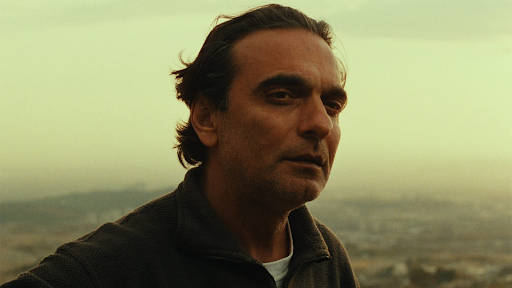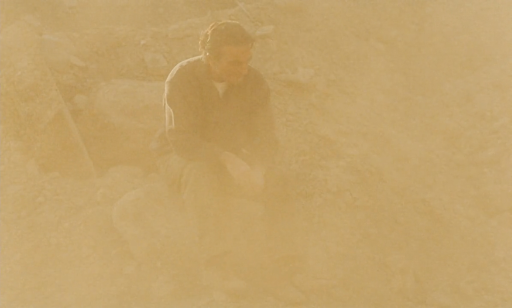[Film Review] Feeling Death in Kiarostami’s ‘Taste of Cherry’ (1997)
As Badii (Homayoun Ershadi) drives along winding dirt roads in Tehran that never seem to end, with chaotic scenes of people and machines flashing by the window beside him, he is framed in a profile mid-shot that accentuates his steely gaze – one fixed unwaveringly on the path ahead. Badii’s visual fixation parallels the figurative one forming the premise of Abbas Kiarostami’s Taste of Cherry (1997): a middle-aged man is determined to commit suicide, and searches for someone who will aid him. In its 96-minute golden-brown haze, Taste of Cherry is an exploration of primal and socio-ethical responses to suicide – from fear, bewilderment, and disdain, to empathy and peace.
For a film fuelled by its protagonist’s desire to die, it is remarkably quiet and almost meditative. Ultimately, Kiarostami eschews literalising depictions of death portrayed as a wild, thrashing beast, and instead, recognising film’s limitations in truly representing complex human realities, opts for a poeticisation of this human condition which establishes fidelity through emotional effects rather than the literal.
Winding dirt roads in Taste of Cherry (1997).
Initially, our understanding of Badii’s mission is uncertain and, indeed, confuses the men he approaches too; a labourer, thinking Badii’s monetary offer is in exchange for sex, threatens to attack him. Even when he explains his offer to a horrified young Kurdish soldier (Afshin Khorshid Bakhtari), Badii’s demeanour subverts what we might expect of someone suicidal – he is logical, composed, and patient. Here, Badii is elevated – framed from a slightly lower angle – and foregrounds the wide, open desert scenery, while the soldier is minimised – filmed from a higher angle– and his uneasy eyeline is cut by the top of the halfway-wound-down car window; these two compositions contrast a sense of freedom and power in the former with claustrophobic smallness in the latter. The choice of framing in their shot-reverse-shot interaction thus mirrors Badii’s confidence and the soldier’s anxiety, subverting our expectations of their dynamic given that Badii is suicidal.
Similarly, Badii’s plan is surprisingly thought-out. He has already dug a grave for himself below a cherry tree, and plans to attempt suicide in the grave that night; all he asks of the soldier is to check on him in the morning – if he is alive, to help him out of the grave, and if he is dead, to bury him.
Homayoun Ershadi leads as Mr. Badii.
The film’s emotional arc relies on Badii’s startling confidence as a starting point because, although its dialogue is subtle and its actions sparse, it builds convincingly to an anxiety-ridden climax when Badii finally finds an old man who will help with the suicide. The plan now in motion, Badii suddenly looks around, eyes wide and disbelieving, at a world he realises he might never see again. His fearful anxiety in the face of mortality is made especially palpable for viewers when, after helping a couple take a picture, Badii abruptly swings his car around to look for the old man at his taxidermy workshop. There, viewers endure an agonising 40-second long-take of Badii pacing back and forth, wringing his hands as he waits for the old man, before we find out what he needs to tell him: “When you come in the morning, bring two stones and throw them at me. I might just be asleep and still alive. [...] Shake my shoulders too. I might still be alive.” This emotionally climatic sequence is a marked difference from the aforementioned conviction with which Badii laid out the suicide plan; it is the first time Badii’s confidence falters, the first time he truly entertains the thought that he might survive the night, the first time we feel his fear of dying despite his desire to – a deeply nuanced emotional journey elucidated through careful pacing, writing, and mise-en-scène.
Thickening dust at a construction site obscures Badii’s figure.
Kiarostami’s subversive emotional arc and characterisation are combined with a co-opting of viewers into its protagonists’ emotional state. Its chronology is constructed with few time-jumps and many long-takes – at one point, we watch for four minutes as Badii watches dirt excavated at a construction site, the ever-shifting texture of its flow distorting his shadow, the thickening dust enveloping his image. The metaphor is visual and beautiful: Badii has been silently consumed by things in life – small like dirt and dust, but, at great volume, powerful enough to obscure the shape of one’s self. The metaphor might be aural too, if we hear the subversive silence of Badii’s suicidal struggle compensated for by the deafening grinding of machinery and falling rocks; the construction site gnashes its teeth in Badii’s place. Kiarostami thus capitalises on filmic techniques – long takes, visual and aural metaphors – to offer viewers the experience of an emotionally complex tangle with suicidal feelings, as opposed to merely viewing a conventionally sensational depiction of the struggle. Kiarostami therefore seems to acknowledge the filmic medium’s limitations in literally depicting the human condition, opting instead to present a poeticisation.
Badii’s shadow against falling dirt.
A further testament to Taste of Cherry’s self-consciousness is found in the bizarre self-reflexivity of its ending. A flash of lightning, and, lying in his grave, Badii’s eyes close; in the darkness, a soundscape transition from thunderstorm to birdsong; fade in on grainy handheld footage of soldiers marching, then ‘Badii’ walking up a hill to pass a cigarette to Kiarostami, who is in the middle of shooting what appears to be Taste of Cherry. At once a vulnerable display of the filmic medium in action and a break in fictional reality that seems to liberate our protagonist from his tormented fictional self, Kiarostami’s closing scene reflects Taste of Cherry’s underlying anxiety: a negotiation of the relationship between the sheer weight of life, death, emotions – the human condition – and the limitations of cinema.




